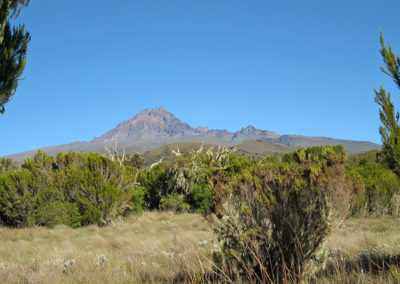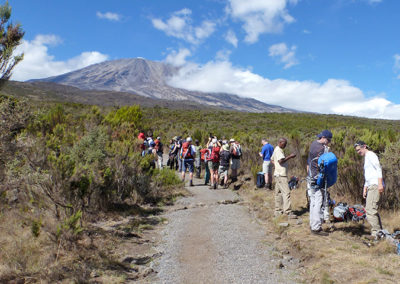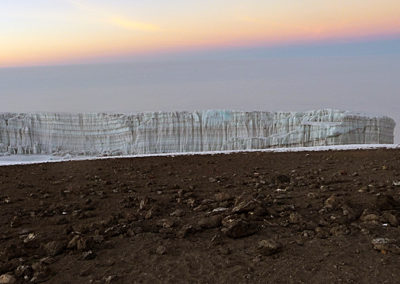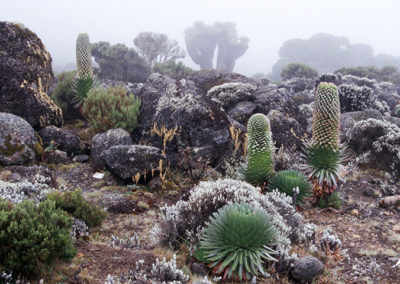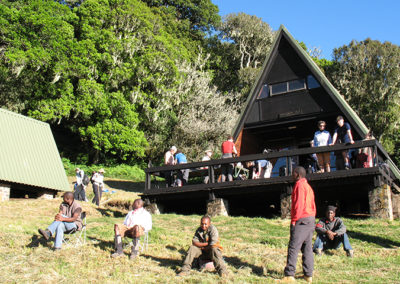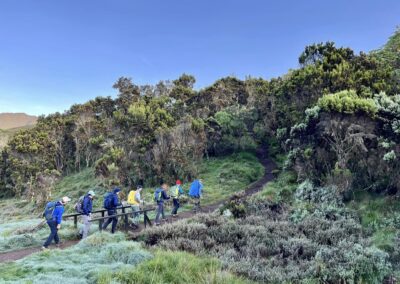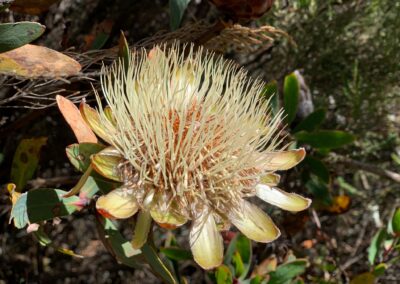About the Marangu Route
Better known as the “Coca-Cola Trail”, the Marangu Route is the oldest, most well-established, and considered the easiest of all Kilimanjaro routes. Marangu is by far the most popular route used for summiting Kilimanjaro. The reason behind this could be the fact that the Marangu is the least expensive route, but more so, perhaps the fact that it is possible to do the Marangu Route in 5 days.
It’s also the only route that offers mountain hut accommodation, a bonus when the weather is not always sunny and dry. All your equipment and supplies are carried by porters and a cook prepares all your meals. The route is less scenic because the ascent and descent are done via the same trails.
- medium difficulty
- good scenery
- high traffic
- good success rate
- overnight stays in mountain huts (good for rainy season)
- up and down the same route
Detailed itinerary
Day 1: Marangu Gate (1860 m) to Mandara Hut (2720 m)
Hiking time: 3-4 h / Distance: 7 km / Ascent: 835 m
The drive from your lodge in Arusha or Moshi to the Kilimanjaro National Park gate, takes about 2 hours. The journey passes through the village of Marangu, which is located on the lower slopes of the mountain. Once you reach the park gate, all climbers are requested to sign in at the Park office and make their final preparations for the climb. Porters will be seen arranging and loading their packs, containing the food, water, cooking gas as well as most of your equipment. Make sure that you have all your daypack items (containing at least 3 litres of drinking water, your lunch box and extra clothing) with you as the porters ascend a lot quicker than the hikers. Our guides will be available to assist with any additional information or needs you might have.
You now leave the Park gate and ascend on a cleared ridge trail through the rain forest. The forest, suffused with mist and dripping with beards of moss, is also where most of Kilimanjaro’s animals are found. A more scenic parallel forest trail for the climbers branches off to the left a few minutes after the gate. This trail follows the edge of a stream through the undergrowth and rejoins the main trail after 1.5 to 2 hours and again after 2 to 2.5 hours. From this final junction it is another 1 to 1.5 hours to Mandara Hut. Your first night stop, Mandara Hut, is a group of wooden A-framed huts in a forest clearing. Each double-roomed hut features 4 sleeping bunks per room with solar-generated lighting. There is a larger brick building nearby to accommodate bigger groups. The total capacity of the camp is 80 climbers. Water is piped into the camp from springs above and there are flush toilets behind the main hut as well as a few wash basins with taps.
Accommodation: Mandara Hut. (-/L/D)
Side Trip: Maundi Crater / Time: 2 h return / Distance: 3 km
From Mandara Hut you can visit nearby Maundi Crater, a small crater rising out of the trees to the north. Views from the top, over the forest up to the main peaks of Kibo and Mawenzi, provide plenty of inspiration for the trek to come. Below, if the weather is clear, there are spectacular views across Tsavo National Park in Kenya, Lake Chala (crater lake) and Lake Jipe. The path is clearly signposted.
Day 2: Mandara Hut (2720 m) to Horombo Hut (3720 m)
Hiking time: 5-6 h / Distance: 11 km / Ascent: 1000 m
From Mandara Hut the trail passes through a short stretch of forest, then skirts the base of the Maundi Crater and then emerges into the transition from rainforest to moorland. On a clear day, Kibo will glimmer in the distance, showing off her majestic glaciers in the morning sun. Once you are in the open moorland you will get the chance to see some of Kilimanjaro’s most spectacular plants – the endemic giant lobelia (Lobelia deckenii) which grows up to 3 m in height and the giant tree groundsel (Senecio Kilimanjari), which can reach heights of 5m! After about 6 hours from here you reach the Horombo Hut, a large group of A-framed wooden huts with two dining huts and two bathroom huts.
Accommodation: Horombo Hut. (B/L/D)
Day 3: Horombo Hut (3720 m) to Zebra Rocks (4000 m)
and/or Kibo Saddle (4200 m) and back to Horombo Hut (3720 m)
Hiking time: 3-5 h / Distance: 5-9 km / Ascent: 480 m / Descent: 480 m
Horombo Hut is a village of huts perched on a small plateau, with buildings similar to Mandara, but with a total capacity of 140 climbers! Horombo is normally bustling with hikers, guides and porters, with an atmosphere of adventure and excitement. You will meet both ascending and descending hikers here. This extra day and night at Horombo is for additional acclimatisation. A hike towards the Mawenzi Hut, passing the Zebra Rocks on the way (about 3 hours up and 1.5 hours down), is strongly recommended. This hike will further assist with the process of acclimatisation. Remember to drink enough water and move slowly! All meals for the day are provided at the hut. Retire to bed early and get a last good night’s rest.
Accommodation: Horombo Hut. (B/L/D)
Day 4: Horombo Hut (3720 m) to Kibo Hut (4703 m)
Hiking time: 5-6 h / Distance: 12 km / Ascent: 983 m
After breakfast you now continue your ascent into the Alpine desert habitat. From Horombo there are two trails to the “Saddle” (which refers to the area located between the peaks of Mawenzi and Kibo). There is an upper route (right hand fork) and lower route (left hand fork) to choose from. The upper route (right hand fork) will be very familiar, as you will have climbed most of it the previous day towards Mawenzi hut. It is very stony and eroded. The recommended lower route (left hand fork) is much easier and nearly an hour shorter and it also passes the last watering point at 4130m. Once again remember to slow down and drink enough water!
Situated in the barren Alpine desert is Kibo Hut, a stone built block house which has bunk beds for 60 climbers, but no streams with water nearby. At this hut there are no possibilities for a wash so make sure you have enough wet wipes on you. There are platform toilets behind the hut. The summit is now a further 1190 m up and you will make your final ascent the same night. Before going to bed it is best to prepare your equipment, walking poles and thermal clothing for your summit attempt. This should include the replacement of your headlamp and camera batteries and make sure you have a spare set available as well. To prevent freezing it will be wise to carry your water in a thermal flask. After an early dinner it is advisable to go to bed at round 19h00 and try to get as much rest and sleep as possible – with your head up on a pillow.
Accommodation: Kibo Hut. (B/L/D)
Day 5: Kibo Hut (4703 m) to Uhuru Peak (5895 m) and down to
Horombo Hut (3720 m)
Hiking time: 12-14 h / Distance: 21 km / Ascent: 1192 m / Descent: 2175 m
You will rise around 23h30, and after some tea and biscuits you shuffle off into the night, and this is where the going really gets tough. The first section of the trail consists of a rocky path to the Hans Meyer Cave (5150 m), also a good resting spot. The path then zigzags up to Gillman’s point (5680 m), which is located on the crater rim. This section is very steep with a lot of stone scree, requiring a great physical and mental effort. This is probably the most demanding section of the entire route. Do the Kili shuffle and move slowly.
From Gillman’s Point you will normally encounter snow or ice (depending on the time of the year) all the way up to Uhuru peak (5895 m), the highest point in Africa. Total exhilaration and satisfaction – you made it. Weather conditions on the summit will determine how long you will be able to spend, taking photographs, before the 3 hour descent back to Kibo hut. However your stay at Uhuru Peak should not extend an hour due to the high altitude. After a short rest and a meal, you gather all your gear you left behind for the ascent at Kibo Hut and head down to Horombo Hut (3 hours) for your last overnight stay on the mountain. The return to Horombo Hut will seem surprisingly fast compared to the ascent. The total time spent walking on this day is around 14 hours, so be prepared for a very tough day. Later in the evening you enjoy your last dinner on the mountain and a well-earned sleep, filled with memories and stirring emotions.
Accommodation: Horombo Hut. (-/Brunch/D)
Day 6: Horombo Hut (3720 m) to Marangu Gate (1860 m)
Hiking time: 5-6 h / Distance: 18 km / Descent: 1880 m
Mandara Hut for a short break or lunch stop, down to the Marangu Gate. It is strongly recommended not to pay your porters any tips until you and all your gear have reached the gate safely. At Marangu Gate you sign your name and details in a register. This is also where successful climbers receive their summit certificates. Those climbers who reached Gillman’s Point (5680 m) are issued with green certificates and those who reached Uhuru Peak (5895 m), receive gold certificates. They also issue certificate if you reach Stella Point (half-way between Uhuru and Gillman’s). Transfer back to your accommodation. (B/-/-)
Requirements
Persons attempting the climb must be physically very fit and in very good general health. You need surefootedness, trekking experience, good physical shape for the hiking stages lasting several hours, team spirit and the ability to forgo comfort.
Please note
Hut accommodation is dormitory-style with bunk beds. Campsites and toilet facilities on the mountain are very basic, water for personal hygiene on the mountain is limited. Clients climb at their own risk. It is at the guide’s discretion to break off a climb in case weather conditions or clients health dictate it for safety reasons.


